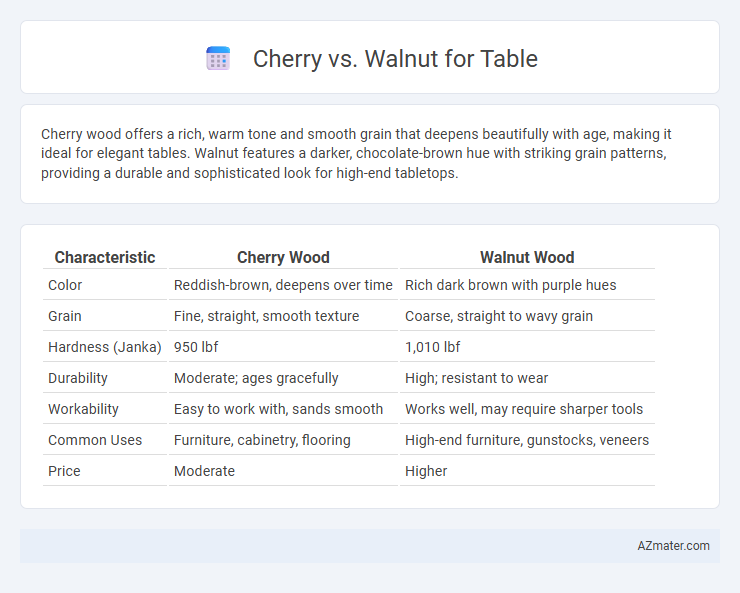Cherry wood offers a rich, warm tone and smooth grain that deepens beautifully with age, making it ideal for elegant tables. Walnut features a darker, chocolate-brown hue with striking grain patterns, providing a durable and sophisticated look for high-end tabletops.
Table of Comparison
| Characteristic | Cherry Wood | Walnut Wood |
|---|---|---|
| Color | Reddish-brown, deepens over time | Rich dark brown with purple hues |
| Grain | Fine, straight, smooth texture | Coarse, straight to wavy grain |
| Hardness (Janka) | 950 lbf | 1,010 lbf |
| Durability | Moderate; ages gracefully | High; resistant to wear |
| Workability | Easy to work with, sands smooth | Works well, may require sharper tools |
| Common Uses | Furniture, cabinetry, flooring | High-end furniture, gunstocks, veneers |
| Price | Moderate | Higher |
Introduction: Cherry vs Walnut for Table Making
Cherry wood offers a warm, reddish-brown hue that deepens with age, making it a popular choice for elegant table making. Walnut provides a rich, dark chocolate-brown color with a straight grain pattern, favored for its durability and sophisticated appearance. Both hardwoods are prized for their strength and workability, influencing the aesthetic and longevity of custom tables.
Appearance and Grain Patterns
Cherry wood exhibits a rich, warm reddish-brown hue that deepens with age, creating an elegant and timeless appeal for tables. Walnut offers a darker chocolate to espresso brown color with occasional purple undertones, featuring a bold, straight grain with subtle waves that contribute to its luxurious, sophisticated look. Both woods showcase unique grain patterns where cherry's smooth, fine texture contrasts with walnut's more pronounced and varied figure, making the choice dependent on desired aesthetic impact and style preference.
Color Variations and Aging Over Time
Cherry wood offers a warm reddish-brown hue that deepens to a rich, mahogany tone as it ages, creating a dynamic color evolution ideal for classic and elegant table designs. Walnut features a range of colors from pale brown to dark chocolate with occasional purple or gray undertones, which tend to mellow with age and exposure to light, enhancing its luxurious and sophisticated appearance. Over time, cherry tables develop a smooth patina and deep richness in color, while walnut tables maintain a consistent dark tone with subtle lightening that adds to their timeless appeal.
Durability and Hardness Comparison
Walnut and cherry wood both offer distinct advantages in durability and hardness for table construction, with walnut typically ranking higher in hardness on the Janka scale at around 1,010 lbf compared to cherry's 950 lbf. Walnut's slightly greater density and resistance to wear make it more suitable for heavy-use environments, while cherry wood provides excellent durability with a smoother finish that improves over time. Both hardwoods resist dents and scratches effectively, but walnut's superior hardness and stability often translate to longer-lasting, robust tables.
Workability: Ease of Cutting and Shaping
Cherry wood offers excellent workability due to its fine, straight grain and relatively soft texture, making it easier to cut and shape with hand and power tools. Walnut, while also considered workable, is slightly harder and denser, requiring more effort and sharper tools for precise cuts and detailed shaping. Both woods respond well to sanding and finishing, but cherry's smoother cutting characteristics often make it a preferred choice for intricate table designs.
Cost Differences and Market Value
Cherry wood is generally more expensive than walnut due to its slower growth rate and rich, reddish-brown hue that is highly sought after for fine furniture. Walnut commands a higher market value in regions where its deep, dark grain patterns and durability are preferred, often resulting in prices comparable to or exceeding cherry in those markets. Cost differences between cherry and walnut tables are influenced by factors such as wood availability, finishing requirements, and current trends in interior design preferences.
Sustainability and Environmental Impact
Cherry wood offers moderate sustainability with its relatively fast growth and widespread availability, making it a more environmentally friendly choice compared to rare hardwoods. Walnut, while prized for its rich appearance and durability, grows slower and is often harvested from old-growth forests, contributing to higher environmental impact and less sustainable sourcing. Choosing cherry wood tables supports better forest management practices and reduces deforestation risk associated with walnut harvesting.
Maintenance and Finishing Techniques
Cherry wood offers a smooth surface that responds well to staining and polishing, enhancing its warm reddish tones while requiring regular oiling or waxing to maintain its rich patina. Walnut is naturally darker and denser, demanding less frequent refinishing but benefits from occasional cleaning with a mild wood cleaner and applying a finish like oil or wax to protect against moisture and wear. Choose cherry for easier refinishing and a softer, more delicate maintenance routine, whereas walnut requires minimal upkeep but careful protection to preserve its deep, rich grain.
Popular Styles and Design Suitability
Cherry wood tables are favored for traditional and rustic styles due to their rich reddish-brown hue and smooth grain that deepens over time, making them ideal for classic, warm interiors. Walnut, with its darker, chocolate brown color and striking grain patterns, suits modern and mid-century designs, providing a sleek, sophisticated look that complements minimalist decor. Both woods offer durability, but cherry's softer tone enhances cozy environments while walnut's bold appearance accentuates contemporary aesthetics.
Final Verdict: Choosing the Best Wood for Your Table
Cherry wood offers a rich, warm reddish-brown hue that deepens over time, making it ideal for elegant tables with a classic appeal. Walnut provides a darker, more consistent grain pattern with exceptional durability, perfect for contemporary and high-traffic tables. For long-lasting beauty and strength, cherry suits traditional aesthetics, while walnut excels in modern, robust table designs.

Infographic: Cherry vs Walnut for Table
 azmater.com
azmater.com